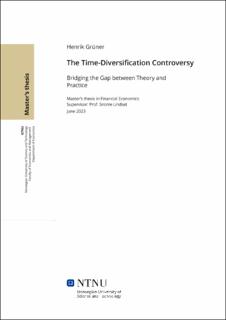| dc.contributor.advisor | Lindset, Snorre | |
| dc.contributor.author | Grüner, Henrik | |
| dc.date.accessioned | 2023-07-11T17:22:20Z | |
| dc.date.available | 2023-07-11T17:22:20Z | |
| dc.date.issued | 2023 | |
| dc.identifier | no.ntnu:inspera:145362779:33700882 | |
| dc.identifier.uri | https://hdl.handle.net/11250/3077875 | |
| dc.description.abstract | Kontroversen rundt tidsdiversifisering er en langvarig debatt om hvorvidt lengre
investeringshorisont reduserer risiko(tidsdiversifisering), og påfølgende bør allokeringen øke med tidshorisont, eller som Samuelson (1969) og Bodie (1991) argumenterer: allokeringen til risikable eiendeler bør være enten konstant eller avtagende over tid. Denne oppgaven bidrar til debatten gjennomå i) gjennomgå litteraturen rundt opphavet til de motstridende meningene, og ii) Undersøke effekten gjennom empiriske data.
Data fra S&P 500 og US Treasury T-Bills fra 1929 til 2023 ble brukt for å danne porteføljer med varierende investeringshorisonter. Resultatene indikerte at når investeringshorisonten økte, sank det annualiserte standardavviket og sannsynligheten for tap og underprestering (i forhold til risikofri rente), mens Sharpe- og Sortino-forholdene økte. 95%-VaR og 95%-cVaR falt også til null når investeringshorisonten var 7 and 12 eller lengre.
Dataene ble også brukt til å løse et optimeringsproblem for allokering av portefølje til risikable eller risikofrie aktiva m.h.t maksimering av forventet nytte, og for å beregne kostnaden ved forsikring mot at porteføljen underpresterer. Begge analyser indikerte reduksjon i risiko med en lengre tids horisont når de ble anvendt på empiriske data, i motsetning til de teoretiske modellene i litteraturen. | |
| dc.description.abstract | The time-diversification controversy is a longstanding debate about whether risk decreases with longer investment horizons (time-diversification), as traditionally advised, or whether, as Samuelson (1969) and Bodie (1991) argue, the allocation to risky assets should be either constant or decreasing over time. This thesis
delves into this debate by reviewing literature and examining empirical data. Data from the S&P 500 and US Treasury T-Bills from 1929 to 2023 was used to form portfolios with varying investment horizons. Results indicated that as investment horizon increased, the annualized standard deviation and probabilities of loss and shortfall diminished, while the Sharpe and Sortino ratios grew. The 95%-VaR and 95%-cVaR also reduced to zero after the investment horizon extended beyond 7 and 12.
The data was also used to solve an optimization problem for wealth allocation to risky assets and to calculate the cost of shortfall insurance. Both frameworks suggested a decrease in risk with a longer time horizon when applied to empirical data, contrary to theoretical findings in the literature. | |
| dc.language | eng | |
| dc.publisher | NTNU | |
| dc.title | Time Diversification - Bridging the Gap Between Theory and Practice | |
| dc.type | Master thesis | |
